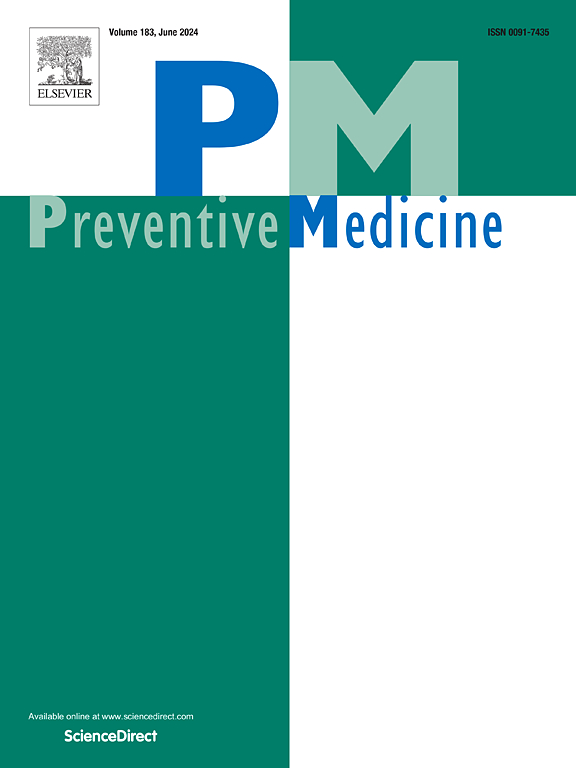2001 年至 2019 年美国与社会经济劣势相关的无烟家庭趋势差异。
IF 4.3
2区 医学
Q1 MEDICINE, GENERAL & INTERNAL
引用次数: 0
摘要
目的研究2001年至2019年美国无烟家庭(SFH)规则普及率趋势的差异,按个人的社会经济劣势数量进行分类:数据来自 2001-2019 年美国当前人口调查烟草使用补充资料,这是一项具有全国代表性的横断面调查。样本包括回答有关 SFH 规则和社会经济劣势(定义为上月失业、收入低于联邦贫困线和/或教育程度低于高中文凭)项目的受访者(年龄≥18 岁)(N = 867,552 人)。多变量逻辑回归估算了采用自费住房规则与社会经济劣势数量之间的关联,包括时间与劣势之间的交互项,以评估差异随时间的变化:SFH的流行率从2001-2002年的64.6%大幅上升至2018-2019年的89.0%。19年间,非吸烟者中因社会经济劣势而导致的SFH患病率差异有所缩小,但吸烟者中的差异却有所扩大。在非吸烟者中,无劣势人群的SFH患病率增加了17.2个百分点(从76.5%上升到93.7%),而有三种劣势人群的SFH患病率增加了24.3个百分点(从61.8%上升到86.1%)。相比之下,在吸烟者中,有一项不利条件(22.8%至51.5%)、两项不利条件(19.5%至45.1%)和三项不利条件(17.3%至37.1%)的吸烟者的 SFH 患病率随时间推移的增长幅度要小于没有不利条件的吸烟者(27.7%至61.4%)。即使在与子女同住的吸烟者中,差距也有所扩大:尽管 SFH 患病率大幅上升,但差距依然存在。我们的研究结果表明,有必要继续努力推广自律吸烟,尤其是在社会经济条件较差的吸烟者中。本文章由计算机程序翻译,如有差异,请以英文原文为准。
Disparities in trends of smoke-free home associated with socioeconomic disadvantages in the United States from 2001 to 2019
Objective
To examine disparities in trends of smoke-free home (SFH) rule prevalence in the United States from 2001 to 2019 by individuals' number of socioeconomic disadvantages.
Methods
Data were drawn from the 2001–2019 Tobacco Use Supplements to the U.S. Current Population Survey, a nationally representative cross-sectional survey. The sample comprised respondents (aged≥18 years) who answered items about SFH rules and socioeconomic disadvantage, defined as past-month unemployment, income below the federal poverty line, and/or education less than a high school diploma (N = 867,552). Multivariable logistic regressions estimated associations between adoption of an SFH rule and the number of socioeconomic disadvantages, including interaction terms between time and disadvantages, to assess changes in disparities over time.
Results
SFH prevalence increased substantially from 64.6 % in 2001–2002 to 89.0 % in 2018–2019. Differences in SFH prevalence by socioeconomic disadvantage narrowed somewhat over the 19 years among non-smokers but widened among smokers. Among non-smokers, SFH prevalence increased by 17.2 ppt (76.5 % to 93.7 %) for those without disadvantages, while it increased by 24.3 ppt (61.8 % to 86.1 %) among those with three disadvantages. In contrast, among smokers, increases in SFH prevalence over time were smaller among those with one (22.8 % to 51.5 %), two (19.5 % to 45.1 %), and three disadvantages (17.3 % to 37.1 %), compared with those without disadvantages (27.7 % to 61.4 %). The widened disparities were found even among smokers living with children.
Conclusion
Despite a large increase in the SFH prevalence, disparities remain. Our findings underscore the need for continued efforts to promote SFH, particularly among socioeconomically disadvantaged smokers.
求助全文
通过发布文献求助,成功后即可免费获取论文全文。
去求助
来源期刊

Preventive medicine
医学-公共卫生、环境卫生与职业卫生
CiteScore
7.70
自引率
3.90%
发文量
0
审稿时长
42 days
期刊介绍:
Founded in 1972 by Ernst Wynder, Preventive Medicine is an international scholarly journal that provides prompt publication of original articles on the science and practice of disease prevention, health promotion, and public health policymaking. Preventive Medicine aims to reward innovation. It will favor insightful observational studies, thoughtful explorations of health data, unsuspected new angles for existing hypotheses, robust randomized controlled trials, and impartial systematic reviews. Preventive Medicine''s ultimate goal is to publish research that will have an impact on the work of practitioners of disease prevention and health promotion, as well as of related disciplines.
 求助内容:
求助内容: 应助结果提醒方式:
应助结果提醒方式:


